金融数学与金融工程专业攻读博士学位研究生培养方案 (专业代码
金融数学与金融工程专业攻读博士学位研究生培养方案
(专业代码:070121)
一、培养目标
本专业培养适合在政府管理、金融保险、金融避险技术、工程技术、环保医学等部门从事信息处理、数据分析、经济预测等方面工作的高级专门人才;同时也为高等院校和科研机构培养能胜任金融数学与金融工程教学科研工作的高层次人才。本专业培养的研究生应能较好地掌握马克思主义基本原理和科学方法论,热爱祖国,坚持党的四项基本原则,具有团结协作精神和坚持真理的科学品质,身心健康。业务方面的要求为:
博士学位获得者应具有坚实、宽广、深厚的概率统计基础知识和系统深入的专门知识。对本学科的现状和发展趋势以及国际学术研究的进展和动向有广泛的了解,能熟练运用计算机在学科和专门技术上做出创造性成果或解决某些重大实际问题。至少掌握一门外国语,能熟练地阅读本专业的外文资料,具有较好的写作能力和国际学术交流的能力。
二、研究方向
(一) 金融数学、金融工程与金融管理
研究股票、期权和其它衍生证券的定价问题,探讨证券的风险控制和随机计算的方法。
(二) 非线性预期与倒向随机微分方程
主要研究倒向随机微分方程的基本理论及其应用,理性与非理性预期。
(三) 金融、保险中的数学理论和应用
研究保险金融中的数学模型,为有关部门提供咨询服务。
(四) 树立金融中的随机控制与随机分析方法
利用随机分析研究经济及金融理论,揭示人们的理性预期、非理性预期以及偏好与信念之间的关系。
三、学习年限
本专业全日制普通博士生的学习年限为3-5年,基本学习年限为3年。
四、应修总学分数
本专业博士研究生应修总学分:不少于15学分。
五、课程设置(具体见课程设置一览表)
1、必修课
马克思主义理论课2学分
第一外国语3学分、专业外语1学分。
学位专业课3门,不少于4学分。
前沿讲座5学分。
(1)讲座课的内容:数学学科及其下属二级学科组织的综合或专题报告会。
(2)通过参加讲座和讨论,研究生要对数学学科当代的重要进展及一些重要的发展方向有较深入的了解,为数学内部各学科之间或同其它学科的交叉研究打下良好的基础。
(3)每学期至少参加5次讲座,在学期间主讲不少于5次,以书面报告的形式进行考核。本课程为5学分。
2、选修课2门,不少于4学分。
3、补修课2门,近世代数与现代泛函分析(未学过该两门课的跨学科或同等学历的博士生必修)
六、中期考核
以中期考核的形式对博士生进行许可综合考试,时间定于二年级上半学期。考核方式以博士生做口头工作汇报,考核小组对博士生的学习成绩、基本知识的掌握、科研能力、科研态度、论文开题、科研成绩的国内各个方面作考核,并给出成绩,成绩合格者,继续攻读学位;成绩不合格者,取消学籍,予以退学。
七、科学研究与学位论文
在学期间,本专业博士研究生须在国内外核心期刊(不包括增刊)上发表二篇以上与学位论文有关的学术论文,或有一篇发表在SCI、EI收录的期刊上的论文。所取得的科研成果均要求研究生为第一作者(单位为山东大学数学院),研究生在学期间发表的文章一律以公开出版或出版清样为准。国内的核心刊物限于:中国科学、科学通报、数学学报、数学年刊、数学进展、应用数学学报、系统科学与数学、应用概率统计、统计研究、数理统计和应用概率、数理统计和管理、数量经济与技术经济研究、经济数学、统计与预测、统计与决策、控制与决策、中国管理科学、中国软科学、金融研究、金融与保险、经济评论、经济科学预测、山东大学学报(自然科学版)。
博士学位论文,要求作者在对所研究的课题在科学理论或专门技术上做出的创造性成果,并在理论或实用方面对本学科发展或社会主义现代化建设具有较大的意义;表明作者掌握了概率统计学科坚实宽广的基础理论和系统深入的专门知识,具有独立从事科学研究的能力。
博士生的论文开题报告应在第三学期初完成。在申请学位论文答辩前3-5个月,向导师和指导小组提交论文初稿,论文经审查合格后,方可申请答辩。
博士研究生在按时完成学习计划并完成学位论文后,经有关专家评审或评阅合格者可参加论文答辩,通过答辩者经院学位分会和校学位委员会投票通过可授予相应的学位。
八、相关学科
基础数学、应用数学、计算数学、运筹学与控制论、理论物理、以及与数量经济学、微生物学、遗传学、信号与信息处理、金融学、模式识别与智能系统、化学、医药学等方面有关的二级学科。
附:阅读文献与书目
(一) 期刊
Journal of Finance and Stochastics Journal of Finance
Probability Theory and Related Fields Math. Rev.
Stochastic Processes and Their Application Annals of Prob.
Journal of Theoretical Probability Annals of Statistics
SIAM Journal on Control and Optimization Econometrica
Mathematical Finance
中国科学 科学通报
数学学报 应用数学学报
数学年刊 数学进展
系统科学与数学 数学物理学报
控制理论与应用 应用概率统计
数理统计与应用概率
(二) 著作
1.黄志远:随机分析引论,华中理工大学出版社。
2.汪家岗:现代概率论基础,复旦大学出版社,1998。
3.陈希孺:高等数理统计学,中国科学技术大学出版社,1999。
4.A. Mukherjea and N. Tserpes:A Measures on Topological Semigroups,Lecture Notes in Math,Vol.547,New York Springer–Verlag,1976。
5.精算数学,上海科技出版社,1998。
6.何声武,汪家岗,严加安:半鞅与随机分析,科学出版社,1995。
7.严加安,彭实戈等:随机分析选讲,科学出版社,1997。
8.I. Karatzas and S.E. Shreve:Brownian Motion and Stochastic Calculus,Springer-Verlag,1998。
9.Oksendal:Stochastic Differential Equations,Springer-Verlag,1998。
10.张尧庭:金融市场的统计分析,广西师范大学出版社,1998。
金融数学与金融工程专业博士研究生教学计划表

第二篇:金融数学与金融工程专业本科生培养计划
金融数学与金融工程专业培养方案(020109)
(Financial Mathematics & Financial Engineering 020109)
一、专业简介(Ⅰ、Major Introduction)
金融数学与金融工程专业是随着经济的发展而设立的一门新的交叉学科,以培养复合型、应用型金融本科人才为目标。经过4年的学习,使毕业生具备良好的数学素养,掌握扎实的金融数学、金融工程和金融管理知识,能够运用金融工具和数量分析方法解决金融实务问题。学生毕业后可以在银行、保险、证券、信托等金融部门从事财务、理财、风险管理工作,也可以在教育、科研部门从事教学、科研工作,或继续攻读研究生学位。
Financial Mathematics & Financial Engieering is a newly founded interdisciplinary subject responding to the fast developing economy, aiming to provide the fundamental theoretical and practical training in several financial areas at undergraduate level. Upon completing the 4 years’ courses, the students will acquire, in addition to advanced mathematical background training, profound knowledge of financial mathematics, financial engineering and financial management. They would be acquainted with the general financial instruments and quantitative analysis techniques in financial pratice. At their graduation, the students are competitive for positions at financial institutions such as banks, insurance companies, security corporations and trust companies. They would be confident in handling financial affairs involving financing, wealth management and risk management. They have also alternatives for positions as scientific researcher and/or teachers at colleges and research institutions, or to pursue further academic career for graduate degrees.
二、培养目标(Ⅱ、Academic Objectives)
“金融数学与金融工程人才培养基地”以培养复合型、应用型金融本科人才为目标,以现代化的教育思想和教育理念,全面整合金融学和应用数学本科专业人才培养计划,全面改革课程体系、教学内容、教学方法和手段,力求在探索新型金融人才培养模式方面有突破、有创新,使该基地建设成为一个集理论性、应用性、技术性为一体的综合性金融人才培养的实验园,成为打破学科、专业界限,实现学科融合,培养跨学科交叉型金融人才的示范地,也成为培养更高层次金融人才的摇篮和输送平台。
“The National Base of Financial Mathematics & Financial Engieering”aims to provide the interdisciplinary theoretical and practical financial training at undergraduate level. It is intended to keep in line with the modern education ideals and schemes, endeavoring to integrate the undergraduate instructing projects of finance and applied mathematics, reform the course system, contents, instructing schemes. The professors and instructors would make their efforts in the innovation in creating the effective instructing modes in financial mathematics. With proper unification of theoretical instruction, financial practices, and the most updated general techniques, the base is to be built as a comprehensive laboratory for the advanced financial brains, and a successful model of interdisciplinary instructing. The graduates would be the most demanding talents for the ever growing financial institutions.
三、培养要求(Ⅲ、Academic Requirement)
要求学生掌握扎实的基本金融理论、金融数学、金融工程和金融管理知识,能够开发、设计、操作新型的金融工具和手段,能够综合运用各种金融工具和数量分析方法解决金融实务问题。
1
Students majoring in Financial Mathematics & Financial Engieering are demanded to acquire proper background training in elementary finance, financial mathematics, financial engineering and financial management, to build up the ability in developing, designing and proper handling of new financial instruments and techniques, and to be capable of using most of the fundamental financial techniques and numerical analysis methods to solve problems in financial practice.
四、学制与学位(Ⅳ、Academic Structure and Degree)
学制四年。
按计划要求完成学业者,授予理学学士学位。
Length of Schooling: 4 years
Students who complete all the required courses will be conferred bachelor’s degrees.
五、学时与学分(Ⅴ、 Credit Hours and College Credits)
总学分:144 (Total Credits:144 )
课程教学学时/学分:2216/133.5
六、专业主干课程(Ⅵ、Main Curriculum)
数学分析、高等代数、概率论、数理统计、经济计量学、西方经济学、货币银行学、会计学、金融工程学、保险学、应用统计、政治经济学。
Mathematical Analysis, Advanced Algebra, Probability Theory, Mathematical Statistics, Econometrics, Western Economics, Money and Banking, Basic Financial Accounting, Financial Engieering, Insurance, Applied Statistics, Political Economics.
七、主要专业实验和实习安排(Ⅶ、Laboratory Practice and Internship Programs)
专业实验包括:应用统计课的计算机上机实验等。
实习包括数据搜集实习和毕业实习等。
Main laboratory practices include those attached to the related courses involving computer programming and/or software aided projects, such as Applied Statistics, etc.
Internship programs include public data processing and/or joint internship programs at the financial institutions.
八、专业优势及特色(Ⅷ、Major Priority and Characteristics)
本专业充分利用自身金融数学的科研和教学优势,结合中国国情和国际金融人才的需求,以科研理论上的创新促进人才培养的创新,构建创新教育模式,利用金融实验室和金融工程与金融数学基地从事实践活动,丰富学生金融实践的经历,提高学生的实际应用能力,培养既掌握现代金融数学理论、又熟悉金融运作,既适应中国国情又具有国际竞争力的金融数学复合型人才。
This major structure takes advantages of the instructing staffs’ research outputs and profound teaching experiences in financial mathematics over decades, betting serious concerns upon the fast expanding Chinese market and the ever growing demands for the international financial talents. The instructing programs are fully innovated with the most updated theoretical advances. The laboratory practices and the internship programs have been enriching students’ experiences on real financial market. The students, upon
2 占总学分的比例: 92% Percentage in Total Credits:92 %) (Curriculum Class Hours/Credits:2216 /133.5
their graduation, would be fairly confident confronting the modern international financial market and the up surging Chinese economy with their broad modern mathematical financial training and the precious experience accumulated in their internship programs.
九、各类课程学时学分比例(Ⅸ、The Partition of Credit Hours by Courses)
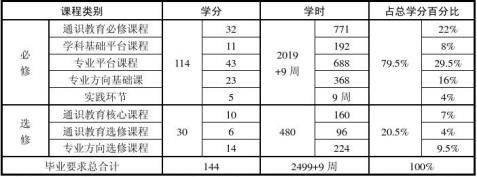
十、教学进程、学时学分总体安排(见下表)(Ⅹ、Curriculum, Hours and Credits)
金融工程专业课程设置及学时分配表 [总表]
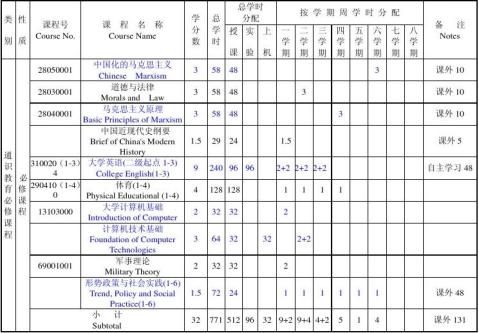
3
4
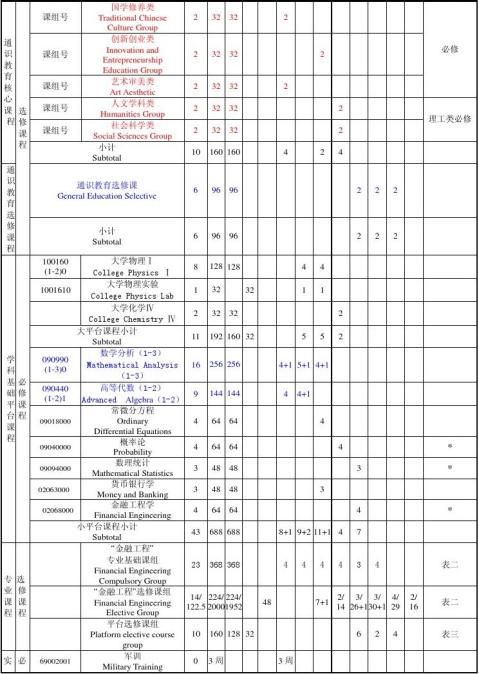
备注:
1.本表必修课部分为专业(大类)必修课(所有学生必须学习的)课程设置表,即综合教务系统中的课程计划表。2.选修课部分为课组设置表,即综合教务系统中的课组计划表。 3.课程号栏目中必修课部分为课程号,选修课部分为课组号。
金融工程专业的专业课程设置及学时分配表(课组课程) [表二]
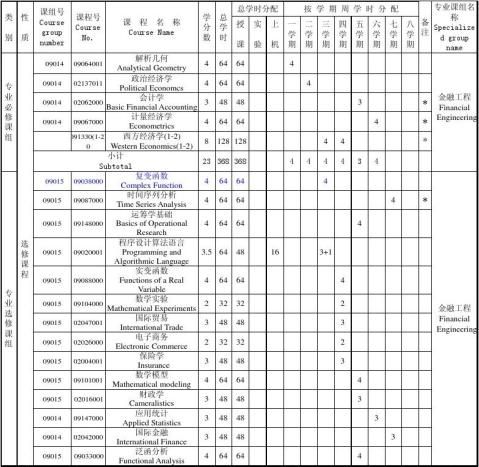
5

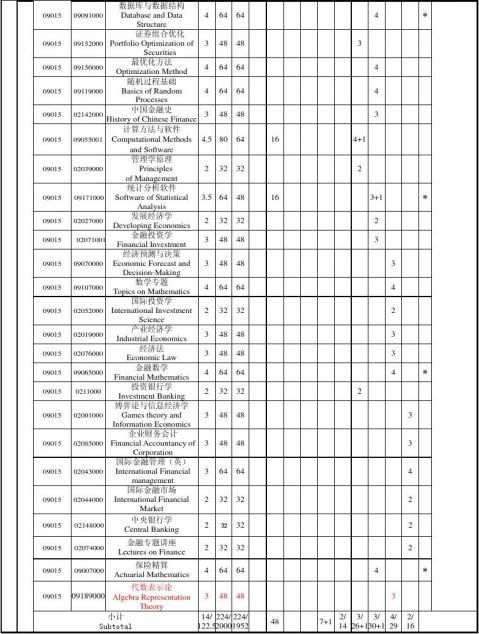
6
金融工程专业平台课程设置及学时分配表 [表三]
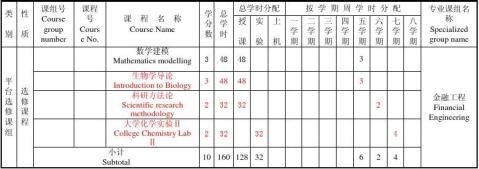
备注:本表为专业课组课程设置表,即综合教务系统中的课程课组对照表。凡是总表必修课程中不能全专业或全专
业大类学生都适用的课程都应进入本表。
教学院长(签字): 学院本科教学指导委员会主任(签字):
年 月 日 年 月 日
7
-
拟攻读博士学位期间的科学研究计划书
拟攻读博士学位期间的科学研究计划书根据李万莉老师的研究方向以及自己的知识储备特点和兴趣爱好在查阅大量文献的基础上若有幸考入同济大学…
-
拟攻读博士学位科学计划书
拟攻读博士学位科学计划书姓名:报考专业:计划书题目:高压脉冲电场灭菌对果醋品质的影响及其在贮藏过程的作用一、立题依据1.1.研究的…
-
攻读博士学位研究生论文课题研究计划书
课题编号攻读博士学位研究生论文课题研究计划书课题名称选题来源研究生姓名年级所在单位学科专业导师姓名职称课题起止时间年月至年月长春中…
-
华中科技大学研究生攻读博士学位期间拟开展的研究计划
华中科技大学研究生攻读博士学位期间拟开展的研究计划说明1本表旨在了解考生专业水平拟订的研究计划入学后可根据导师的意见作出调整2考生…
-
攻读博士学位阶段拟开展的研究计划
华南师范大学年报考博士学位研究生拟开展的研究计划书说明1本表旨在了解考生专业水平拟定的研究计划入学后可以根据博士论文方向和导师意见…
-
攻读博士学位期间拟进行的科学研究设想
研究方向高温碳氢燃料冷却系统的不稳定性研究博士研究生科学研究设想申请人XXX报考导师XXX教授20xx年9月28日目录一前言11自…
-
拟攻读博士学位期间的科学研究计划书
拟攻读博士学位期间的科学研究计划书根据老师的研究方向以及自己的知识储备特点和兴趣爱好在查阅大量文献的基础上若有幸考入大学机械工程学…
-
20xx年攻读博士学位期间拟开展的研究计划
表三中山大学攻读博士学位期间拟开展的研究计划本表请用A4纸双面打印说明1本表旨在了解考生专业水平拟订的研究计划入学后可以根据导师的…
-
攻读博士学位研究生论文课题研究计划书
课题编号攻读博士学位研究生论文课题研究计划书课题名称选题来源研究生姓名年级所在单位学科专业导师姓名职称课题起止时间年月至年月长春中…
-
拟攻读博士学位期间的科学研究计划书
拟攻读博士学位期间的科学研究计划书根据李万莉老师的研究方向以及自己的知识储备特点和兴趣爱好在查阅大量文献的基础上若有幸考入同济大学…